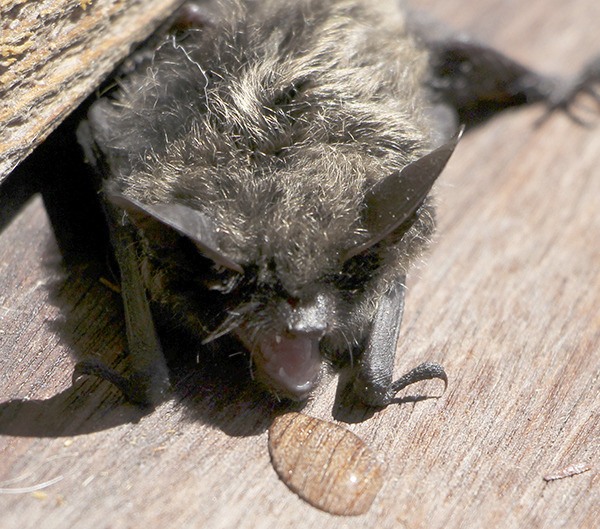Most homes in San Juan County are still being built without regard for the way they attract bats, says Kwiaht ecologist Russel Barsh. The result is scores of preventable conflicts between people and bats each year, which in the past have frequently led to the eviction of bats and decimation of bat populations in the islands.
Bats are San Juan County’s most diverse and abundant mammals. Barsh has been able to identify nine species of bats in the islands since 2013 by recording and analyzing the sound spectra of bats’ echolocation chirps.
“I’ve recorded more than 500 night passes by bats over some of the islands’ lakes and ponds in summer,” Barsh says. Island bats fly less often in winter, he found, and tend to hunt in wooded areas rather than open waters.
To better monitor bats’ seasonal movements, and response to changing weather patterns, Barsh has been installing weatherproofed ultrasound recorders on Lopez, Orcas, and San Juan Islands that will continue to “eavesdrop” on bats nightly for years. He has identified bats from nearly 20,000 flyovers recorded thus far.
“Once or twice a month,” Barsh says, “I get a call from an island homeowner who has found a live bat inside a bedroom, bathroom or storage area; or found evidence of a bat colony living inside an attic, roof or crawl space; or discovered dozens of sleepy bats while re-roofing or re-shingling.”
While there is little cause for fear—there has been no case of humans contracting rabies or another disease from contact with a bat in San Juan County—homeowners are often concerned about smell, dampness, unsightly guano (good in the garden but not on the carpet), Kwiaht helped 156 San Juan County homeowners with excluding bats from living space, or from roofs or walls so that homes can be insulated or re-surfaced. Kwiaht has also designed and built 11 custom bat houses for displaced bats colonies.
Some boxes are large enough for 200 bats. Re-homing a bat colony is tricky. Barsh says that a 50 percent success rate is very good. A better approach, cheaper and less stressful for humans and less likely to harm any bats, is to design and build our homes with bats in mind.
Tiles, shingles, unscreened vents, and cracks or spaces greater than half an inch in width on the roof or exterior walls of a home offer day roosts for bats, especially if they have rough surfaces such as cedar shakes or unfinished sawn timbers. Bats try to squeeze into small spaces to conserve body heat. A single tile roof can be home to a hundred or more bats. Day use of exterior surfaces rarely interferes with human activity, in any case, and tiles, shingles and clapboards can be replaced in fall when bats disperse for winter.
If an exterior gap leads into an attic, wall or crawl space, however, bats may form a maternity colony with dozens to hundreds of related females gathering every year from April to August to birth and nurse bat pups. Colonies are few; only about one in ten of the homes that Barsh has been asked to assess. But warm, dry, safe colonies are critical to the survival of our islands’ bats, and may be protected by law. Enticing a colony to a new home such as a custom bat house, and discouraging it from returning to its original home, can be a two- or three-year process.
Bats are easy to exclude from potential entry holes with hardware cloth. Unlike rats, they do not gnaw through wood or metal. But installing hardware cloth patches after a home has been built can be tedious and costly.
Barsh says that gaps around the ends of roof beams, loose flashing around chimneys and sky lights, and narrow spaces between overhanging roofs and walls are the entry points he finds most frequently. These defects, and the choice of materials for roofs and exterior walls, can all be addressed when houses are designed and built.
“Bats are beneficial neighbors, nonetheless” Barsh says, pointing out bats are the main predators of the moths whose caterpillars damage orchards and gardens each in the islands, as well as the principal natural control of mosquitoes and biting flies. “You don’t want bats to leave your property; just not necessarily to live inside your home.” Kwiaht’s recommended solution is including an exterior space for bats in the original designs for a house.
“It can be as simple as a deep, narrow slot beneath the eaves, warmed by the heat from inside the house, that can be detached temporarily if needed for home repairs.” This gives bats their own separate, warm apartment, and in return, bats sweep the surrounding area of moths and mosquitoes and leave homeowners a neat outdoor pile of guano for the garden.
For further information contact: kwiaht@gmail.com




